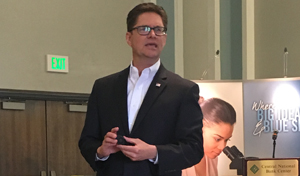Eating healthy is just a lot of talk.
Chris Chanski, vice president of national accounts for AdvancePierre Foods, said there’s a lot of talk about people wanting to eat healthily, but farmers, restaurateurs, and retailers shouldn’t change their businesses yet.
“You’re going to see articles about people wanting to eat healthy,” he said. “But habit will stop that. If you change your business model based on what people talk about, you’ll be lost.”
Chanski spoke at the Oklahoma Future of Food Forum, hosted by the Enid Regional Development Alliance at the Central National Bank Center. AdvancePierre Foods has Enid roots and is the city’s largest private employer.
He said he gets questions from restaurateurs about carrying gluten-free products. But people who have celiac disease, which causes them to not process gluten properly, are only a minute percentage of the population, he said, and he doesn’t think the gluten-free trend has longevity.
Snacks, on the other hand, are here to stay. Chanski said that by 2024, there will be a 12-percent increase in snack-food consumption, driven by millennials and Generation Z.
There’s also a global increase in demand for protein, said Scott McWilliams, regional training manager for Consolidated Grain and Barge Enterprises Inc. The company has 21 locations in Oklahoma, with 98 facilities in the U.S. Thirty-five of those sites are along a river.
McWilliams said the protein demand is driven by people having higher incomes, which spurs them to move to urban areas. When they have more money, they want to eat healthier, he said.
“This is the biggest change in agriculture in the last 20 years,” he said.
But he didn’t talk about cattle, he talked about soybeans. It takes protein to produce protein, and soybean meal is a supplement in cattle feed, making soybeans a popular crop worldwide.
This year, the U.S. will grow more soybeans than corn for the first time, McWilliams said. Nearly 90 million acres of soybeans are being grown this year.
But the U.S. isn’t alone in soybean production. Brazil and Argentina have jumped on board, with Brazil producing as much as China needs annually. China is the largest importer of protein, worldwide.
As soybean production has increased, wheat production has been reduced, and this year will be a record low for U.S. wheat production.
McWilliams said his company is starting to transport non-genetically modified corn in other states. He said CBG has the infrastructure in Oklahoma to ship it as well, but it’s not as high-yielding as GMO corn.
Non-GMO corn has to be separate from other corn, from planting to shipping. There is demand for it in Japan and Korea, he said, and the European Union considers GMOs unsafe. So do 80 percent of U.S. consumers.
“I haven’t found anything that says I’m going to die eating them,” he said. “We have to be able to feed billions of people.”
He said consumers may be seeking organic, non-GMO, fairly traded, locally grown produce, but they want it to be affordable.
The roomful of agriculture-related business leaders laughed at that comment.
“I think the food we’re eating today is healthier than it’s ever been,” he said.
Story by: Molly Fleming with The Journal Record


